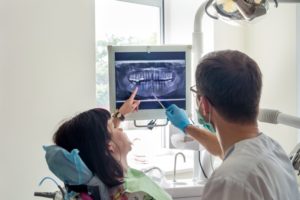
Gum (periodontal) disease is a condition that millions of American adults suffer from. Gingivitis and periodontitis are two stages of the disease, but how do they differ? As you continue reading, your dentist in Lawrenceville provides a simple explanation so you can know what symptoms to be on the lookout for and get the necessary treatment to fully restore your oral health!
What is Gingivitis?
Oral bacteria are always present. However, they grow exponentially throughout the day as you eat and drink, quickly forming plaque. The sticky substance first gathers on your teeth, but if not addressed, it can sink beneath the gum line to cause germ pockets to form. This is considered the first stage of gum disease, which is referred to as gingivitis.
Here are some of the common warning signs:
- Redness
- Bleeding
- Sensitivity
- Tenderness
- Swelling or puffiness
The sooner you reach out to your dentist for treatment, the better off you’ll be. In many cases, a thorough teeth cleaning that removes plaque and tartar can do wonders. Then, as long as you follow your dentist’s dental hygiene recommendations, which will likely include stepping up your toothbrushing and flossing efforts, you’ll see immediate results.
What is Periodontitis?
Gingivitis that is ignored will only get worse over time. That’s because oral bacteria won’t stop encroaching on their own. Thus, the accumulation can eventually lead to periodontitis.
At this point, you run the risk of enduring permanent damage to the ligaments and cementum beneath your gums that hold your teeth in place. More severe cases can even result in diminished jawbone mass and tooth loss.
Typically, dentists will use one of the following methods to treat periodontitis:
- Scaling – Special dental tools are used to remove plaque and tarter buildup, as well as damaged tissue.
- Root Planing – The roots are smoothed to help prevent future accumulations.
- Antibiotics – Oral or topical antibiotics may be needed to stop the growth of bacteria beneath the gum line.
For more acute cases, gum surgery may be required to restore gum health.
Ways to Prevent Gingivitis and Periodontitis
Prevention is always much easier than treatment. Here’s what you can do to protect yourself:
- Brush your teeth for two minutes at least two times a day.
- Floss between each tooth and at the gum line at least once a day.
- Visit your dentist semi-annually for cleanings and checkups.
- Abstain from smoking and chewing tobacco.
- Monitor your consumption of sugary foods and beverages.
You don’t have to settle for gum disease and poor oral health. Instead, follow the above suggestions and be sure to maintain a relationship with your local dentist so that you can enjoy a healthy and functional smile for years to come!
About the Author
Dr. Bruce E. Carter earned his dental degree from the University of Florida College of Dentistry. Throughout a career that has spanned over 30 years, he has taken more than 1,600 hours of advanced training, which includes specialized restorative procedures. Dr. Carter treats gum disease at Transforming Smiles, and he can be reached for more information or to schedule a visit through his website.
